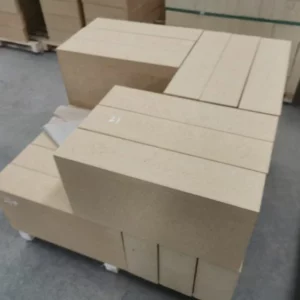Fire bricks are one type of refractory material that is commonly used in high-temperature industrial applications.
Here’s how they compare to other types of refractory materials:
Castables: Refractory castables are another type of refractory material that is often used in industrial applications. Castables are made from refractory aggregates and a binder material that can be poured or troweled into place. Compared to fire bricks, castables are more versatile and can be used to create custom shapes and linings. However, they are less durable than fire bricks and can be more prone to cracking or spalling over time.
Ceramic fiber: Ceramic fiber is a type of refractory material made from spun or woven fibers of alumina, silica, or other refractory materials. Ceramic fiber materials are lightweight and have excellent thermal insulation properties. They are often used in applications where weight is a concern, or where thermal insulation is the primary concern. However, they are not as durable as fire bricks and can be more prone to erosion or chemical attack.
Refractory coatings: Refractory coatings are used to protect refractory linings from chemical attack and erosion. Compared to fire bricks, coatings are less durable and are best used as a supplement to a refractory lining rather than a replacement.
Refractory plastics: Refractory plastics are similar to castables but have a higher water content, which makes them more pliable and easier to shape. fire brick manufacturing They are often used for patching or repairing damaged refractory linings and can be a good alternative to fire bricks in some applications. However, they are not as durable as fire bricks and may need to be replaced more frequently.
Overall, fire bricks are a popular choice for many industrial applications that require high-temperature resistance and durability. While other refractory materials may offer certain advantages, fire bricks are often the preferred choice for applications where durability and long-term performance are a top priority.
How do fire bricks compare to other refractory materials in terms of cost?
The cost of fire bricks and other refractory materials can vary widely depending on factors such as the type of material, the supplier, and the size of the order. In general, fire bricks tend to be more expensive than some other types of refractory materials, such as ceramic fiber or refractory coatings.
Here are some factors that can influence the cost of different types of refractory materials:
Raw materials: The cost of raw materials can vary depending on the availability and demand for the materials used to make the refractory product. Fire bricks are typically made from high-quality refractory materials such as alumina and silica, which can be more expensive than the materials used to make other refractory products.
Manufacturing process: The manufacturing process used to make the refractory product can also affect the cost. For example, fire bricks may require more labor-intensive manufacturing processes, such as shaping and firing, which can add to the cost.
Customization: If a refractory product needs to be customized to fit a specific application, this can also add to the cost. Fire bricks can be cut or shaped to fit specific applications, but this customization can add to the cost compared to off-the-shelf products.
Supplier: The cost of refractory materials can also vary depending on the supplier. Different suppliers may have different pricing structures based on their overhead costs and profit margins.
Overall, fire bricks tend to be more expensive than some other types of refractory materials, but they are also more durable and long-lasting, which can make them a cost-effective choice in the long run. The cost of refractory materials should be considered along with other factors such as performance, durability, and suitability for the application when making a purchasing decision.
